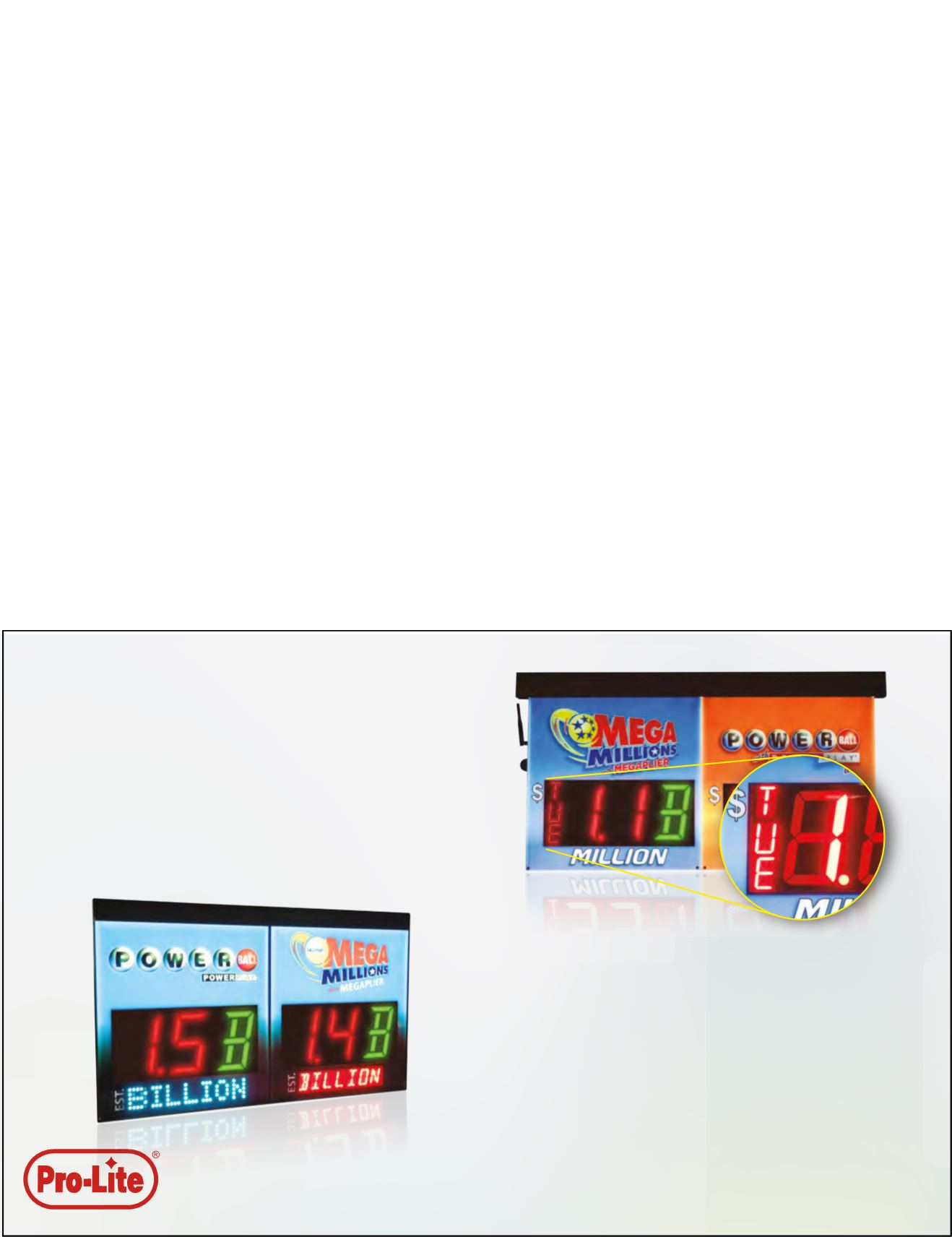
 Engage the Player.
3505 Cadillac Ave., Bldg. D, Costa Mesa, California 92626
US Toll Free 1.855.533.5225 • Local/International 1.714.768.6001 • sales@pro-litelottery.com • www.pro-litelottery.com
© Copyright 2016. Pro-Lite, Inc.
Moving from
Million to Billion
Ticket sales spike on the day of drawing (DOD).
Accordingly to our lottery customers, increase up to
700% on the draw day, and over 400% one day prior to
draw day.
Customers have found that the optimal modes is to turn
the display to static-on with the next draw date right after
the drawing. Slow-flash one day before the drawing and
faster-flash on the day of drawing.
The Billions are coming!
The programmable “Billion” display is offered in dot matrix,
lamps, and 14 segment LED. As a free upgraded feature,
Pro-Lite also offers the big “B” in multi-color free of charge.
Engage the Player.
3505 Cadillac Ave., Bldg. D, Costa Mesa, California 92626
US Toll Free 1.855.533.5225 • Local/International 1.714.768.6001 • sales@pro-litelottery.com • www.pro-litelottery.com
© Copyright 2016. Pro-Lite, Inc.
Moving from
Million to Billion
Ticket sales spike on the day of drawing (DOD).
Accordingly to our lottery customers, increase up to
700% on the draw day, and over 400% one day prior to
draw day.
Customers have found that the optimal modes is to turn
the display to static-on with the next draw date right after
the drawing. Slow-flash one day before the drawing and
faster-flash on the day of drawing.
The Billions are coming!
The programmable “Billion” display is offered in dot matrix,
lamps, and 14 segment LED. As a free upgraded feature,
Pro-Lite also offers the big “B” in multi-color free of charge.
PGRI_Half_OUTPUT_101816.pdf 1 10/20/16 12:05 PM
There are also other local issues that are even more difficult (at
least for lotteries) to standardize: like requirements of local au-
thorities, or local payment and identification systems.
How can Lottery develop games that appeal to the powerful con-
sumer trends of social networking and long-playing casual games
of entertainment on Mobile? How can Lottery tap into the non-
wagering Mobile Gaming phenomenon? Should Lottery try to de-
velop a third-party game development strategy like Apple and other
content marketers?
Jari Vähänen:
The psychology in casual games and money
games is very different. They are different games, different play-
styles, and don’t mix at all with Lottery.
Ellen Vanden Berghe:
I am personally not convinced this is
something Lotteries should do, or are capable of doing. Creating
fresh, new, and attractive games and playing experiences is key. More
partnerships that result in more exciting games will help the indus-
try. That is especially true for smaller lotteries like ours. An in-house
game development department needs a staff of at least 40 people—
from concept development, story tellers, copy writers, designers, de-
velopers, testers, etc. The cost of that can be hard to absorb when the
revenue potential is limited by market size. But enlisting a cavalry of
third-party developers like Apple does is probably neither practical
nor desirable for government-gaming operators.
What do you see as the most pressing need for Lottery to address over
the next three years—especially as it might relate to the “Digital
Transformation in Marketing?”
Anita Bánki:
Szerencsejáték Ltd. obtained great results by
developing strategies to connect with consumers on social plat-
forms. Our Facebook group reached a follower base of 120,000
where people not only access information about our services, but
interact with us on a range of different topics. Since sports betting
is used as a pilot for developments, we launched our Tippmixpro
Twitter channel to take advantage of the potential of live sport
events. We need to invest in the technologies and tools that en-
able us to improve our understanding of our customers.
Mobile applications, such as Tippmix Radar, scan the betslip
and keep track of the results real-time, notifying the player about
winning. Self-service functionality allows players to make their
selection on their own mobile devices or touchscreens available
in retail, generating an ID that can be entered into the terminal.
No coupons are required. The apps and webpages direct players
to the nearest open shop based on their GPS coordinates.
Lene Finstad:
The most pressing matter for the lotteries is
to shift the focus of the business from being product oriented
to being customer oriented. We need to get all our players to
register. That is the basis for the genuinely interactive relation-
ship that is so vital to creating a path for healthy and sustainable



















